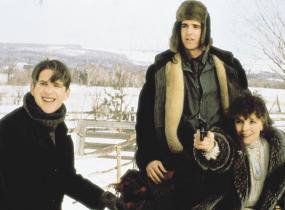Pauline Kael
“Mrs. Soffel gets into a great subject: repressed, often well-educated women who fall in love with prisoners--men in cages….
“…. Gillian Armstrong doesn't lay out the reasons for what happens; she evokes them partially, suggestively, inviting you to fell your way into Kate Soffel's disappointment with her marriage. We can see the torment and dissatisfaction in Kate's face, and the neurasthenia that has kept her in bed for three months…. Surrounded by husband, children, and servants, the imprisoned Kate sits in her tightly bound clothes; under the curls on her forehead, her eyes are full of misery…. [T]here's something about her that makes you uneasy; she's telling the prisoners that faith will do something for them that it has obviously failed to do for her.
“What's daring in the way Gillian Armstrong presents this love story is that we don't quite trust the emotions of either Kate Soffel or Ed Biddle. She's sickly, frustrated, unstable; he's an opportunist, with only one opportunity--to make her love him so madly that she'll bring him and Jack the saws they need to get out…. But Kate isn't a fool, and she's twelve years older than Ed; she's aware of how he's trying to use her. At the same time, she's sexually aroused by him--he's like a trapped animal reaching out to her, pulling her up against his cell.
“Mel Gibson … is superb here…. [Ed] puts the squeeze on Mrs. Soffel, and it makes her feel alive; it takes a while before we realize that she does the same for him. Diane Keaton has trouble with the period role: her fast, distraught, manner of speaking, the words she emphasizes, the ones she throws away--it's all very specifically modern. So is her conception of neurosis, and so, I think, is the tender, easy manner Kate has with her children. (Shouldn't she be more erratic, taking out some of her suffering on them, or, at least, be negligent and indifferent?) But she has a moment here that's freakishly inspired: Ed has been holding her against the bars and she has been speaking like a moral exemplar when suddenly, in mid-sentence, she lets out a dirty little giggle. We know then that Kate is living in a fever dream and doesn't want to wake up. And the post-hippie diction and the other surface flaws in Keaton's performance fade into relative insignificance, because the things that come from inside are so startingly right. Kate has a broad, lewd smile when she holds out her Bible to Ed--with the saws in it….
“…. One thing that makes their love story different from the familiar ones is that they finally come clean with each other….
 “…. [T]he movie builds an excitement that has something to do with the fact that the flight of the Biddles with Kate in tow is deranged. They're killing each other by staying together, yet you can see that staying together is all that matters to them. When the three of them are out in the snow, rushing toward the border, the hurrying about makes Kate flush, and her eyes and teeth shine--she seems elated and glamourous. She's experiencing freedom, and the feelings that were buried in her are released. When a stranger says something grossly insensitive in her presence, and she slaps him, all her senses seem to be whirring. She's a Victorian madwoman heroine.”
“…. [T]he movie builds an excitement that has something to do with the fact that the flight of the Biddles with Kate in tow is deranged. They're killing each other by staying together, yet you can see that staying together is all that matters to them. When the three of them are out in the snow, rushing toward the border, the hurrying about makes Kate flush, and her eyes and teeth shine--she seems elated and glamourous. She's experiencing freedom, and the feelings that were buried in her are released. When a stranger says something grossly insensitive in her presence, and she slaps him, all her senses seem to be whirring. She's a Victorian madwoman heroine.”Pauline Kael
The New Yorker, Dec. 24, 1984
State of the Art, pp 290-293

